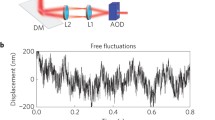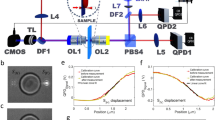Abstract
Recent studies suggest a link between adenosine triphosphate (ATP) concentration and the amplitude of cell membrane flickering (CMF) in the human erythrocyte (red blood cell; RBC). Potentially, the origin of this phenomenon and the unique discocyte shape could be active processes that account for some of the ATP turnover in the RBC. Active flickering could depend on several factors, including pH, osmolality, enzymatic rates and metabolic fluxes. In the present work, we applied the data analysis described in the previous article to study time courses of flickering RBCs acquired using differential interference contrast light microscopy in the presence of selected effectors. We also recorded images of air bubbles in aqueous detergent solutions and oil droplets in water, both of which showed rapid fluctuations in image intensity, the former showing the same type of spectral envelope (relative frequency composition) to RBCs. We conclude that CMF is not directly an active process, but that ATP affects the elastic properties of the membrane that flickers in response to molecular bombardment in a manner that is described mathematically by a constrained random walk.






Similar content being viewed by others
Abbreviations
- ATP:
-
Adenosine triphosphate
- BSA:
-
Bovine serum albumin
- CMF:
-
Cell membrane flickering
- CRW:
-
Constrained random walk
- DIC:
-
Differential interference contrast
- HEPES:
-
4-(2-Hydroxyethyl)-1-piperazineethanesulfonic acid
- GAPDH:
-
Glyceraldehyde-3-phosphate dehydrogenase
- Ht :
-
Haematocrit
- HT:
-
Heat-treatment
- NEM:
-
N-Ethylmaleimide
- OA:
-
Okadaic acid
- PDAc:
-
Phorbol 12,13-diacetate
- PKC:
-
Protein kinase C
- RBC:
-
Red blood cell
References
Bauer J, Lauf PK (1983) Thiol-dependent passive K/Cl transport in sheep red cells: III. Differential reactivity of membrane SH groups with \(N\)-ethylmaleimide and iodoacetamide. J Memb Biol 73:257–261
Ben-Isaac E, Park YK, Popescu G, Brown FLH, Gov NS, Shokef Y (2011) Effective temperature of red-blood-cell membrane fluctuations. Phys Rev Lett 106:238103
Benesch RE, Benesch R (1954) Relation between erythrocyte integrity and sulfhydryl groups. Arch Biochem Biophys 48:38–42
Bennett V, Baines AJ (2001) Spectrin and ankyrin-based pathways: metazoan inventions for integrating cells into tissues. Physiol Rev 81:1353–1392
Betz T, Lenz M, Joanny JF, Sykes C (2009) ATP-dependent mechanics of red blood cells. Proc Natl Acad Sci USA 106:15320–15325
Blowers R, Clarkson EM, Maizels M (1951) Flicker phenomenon in human erythrocytes. J Physiol 113:228–239
Boss D, Hoffmann A, Rappaz B, Depeursinge C, Magistretti PJ, Van de Ville D, Marquet P (2012) Spatially-resolved eigenmode decomposition of red blood cells membrane fluctuations questions the role of ATP in flickering. PLoS One 7:e40667
Brochard F, Lennon JF (1975) Frequency spectrum of the flicker phenomenon in erythrocytes. J Phys (Fr) 36:1035–1047
Browicz T (1890) Weitere beobachtungen uber bewegungsphanomene an roten blutkorperchen in pathologischen zustanden. Zbl Med Wissen 28:625–627
Cabot RC (1901) A guide to the clinical examination of the blood, 4th edn. Longmans, Green and Co., London
Castagna M, Takai Y, Kaibuchi K, Sano K, Kikkawa U, Nishizuka Y (1982) Direct activation of calcium-activated, phospholipid-dependent protein kinase by tumor-promoting phorbol esters. J Biol Chem 257:7847–7851
Cohen P, Holmes CFB, Tsukitani Y (1990) Okadaic acid: a new probe for the study of cellular regulation. Trends Biochem Sci 15:98–102
Connor J, Schroit AJ (1990) Aminophospholipid translocation in erythrocytes: evidence for the involvement of a specific transporter and an endofacial protein. Biochemistry 29:37–43
Evans J, Gratzer W, Mohandas N, Parker K, Sleep J (2008) Fluctuations of the red blood cell membrane: relation to mechanical properties and lack of ATP dependence. Biophys J 94:4134–4144
Feig SA, Shohet SB, Nathan DG (1971) Energy metabolism in human erythrocytes: I. Effects of sodium fluoride. J Clin Invest 50:1731–1737
Fricke K, Sackmann E (1984) Variation of frequency spectrum of the erythrocyte flickering caused by aging, osmolarity, temperature, and pathological changes. Biochim Biophys Acta Mol Cell Res 803:145–152
Gov NS, Safran SA (2005) Red blood cell membrane fluctuations and shape controlled by ATP-induced cytoskeletal defects. Biophys J 88:1859–1874
Green FA (1967) Erythrocyte membrane sulfhydryl groups and Rh antigen activity. Immunochemistry 4:247–257
Grimes AJ (1980) Human red cell metabolism. Blackwell Scientific Publications, Oxford
Krol AY, Grinfeldt MG, Levin SV, Smilgavichus AD (1990) Local mechanical oscillations of the cell surface within the range 0.2–30 Hz. Eur Biophys J 19:93–99
Kuchel PW (2004) Current status and challenges in connecting models of erythrocyte metabolism to experimental reality. Prog Biophys Mol Biol 85:325–342
Levin S, Korenstein R (1991) Membrane fluctuations in erythrocytes are linked to MgATP-dependent dynamic assembly of the membrane skeleton. Biophys J 60:733–737
Malenka RC, Madison DV, Nicoll RA (1986) Potentiation of synaptic transmission in the hippocampus by phorbol esters. Nature 321:175–177
Manno S, Takakuwa Y, Mohandas N (2005) Modulation of erythrocyte membrane mechanical function by protein 4.1 phosphorylation. J Biol Chem 280:7581–7587
McIntyre LM, Thorburn DR, Bubb WA, Kuchel PW (1989) Comparison of computer simulations of the F-type and L-type non-oxidative hexose monophosphate shunts with 31P-NMR experimental data from human erythrocytes. Eur J Biochem 180:399–420
Park YK, Best-Popescu CA, Dasari RR, Popescu G (2001) Light scattering of human red blood cells during metabolic remodeling of the membrane. J Biomed Opt 16:011013
Park YK, Best CA, Auth T, Gov NS, Safran SA, Popescu G, Suresh S, Feld MS (2010) Metabolic remodeling of the human red blood cell membrane. Proc Natl Acad Sci USA 107:1289–1294
Puckeridge M, Kuchel PW (2014) Membrane flickering of the human erythrocyte: described by a constrained random walk. Eur Biophys J (Accompanying article)
Puckeridge M, Chapman BE, Conigrave AD, Grieve SM, Figtree GA, Kuchel PW (2013) Stoichiometric relationship between Na\(^+\) ions transported and glucose consumed in human erythrocytes: bayesian analysis of \(^{23}\)Na and \(^{13}\)C NMR time course data. Biophys J 104:1676–1684
Szekely D, Yau TW, Kuchel PW (2009) Human erythrocyte flickering: temperature, ATP concentration, water transport, and cell aging, plus a computer simulation. Eur Biophys J 38:923–939
Takeuchi T, Nishino K, Itokawa Y (1984) Improved determination of transketolase activity in erythrocytes. Clin Chem 30:658–661
Thomas TH, West IC, Wilkinson R (1995) Modification of erythrocyte Na\(^+\)/Li\(^+\) countertransport kinetics by two types of thiol group. Biochim Biophys Acta Biomembr 1235:317–322
Tuvia S, Almagor A, Bitler A, Levin S, Korenstein R, Yedgar S (1997) Cell membrane fluctuations are regulated by medium macroviscosity: evidence for a metabolic driving force. Proc Natl Acad Sci USA 94:5045–5049
Yau TW, Kuchel RP, Koh JMS, Szekely D, Mirtschin PJ, Kuchel PW (2012) Cytoskeletal rearrangements in human red blood cells induced by snake venoms: light microscopy of shapes and NMR studies of membrane function. Cell Biol Int 36:87–97
Acknowledgments
The research was supported by a Discovery Project Grant from the Australian Research Council to PWK (DP0345961) and an Australia Postgraduate Award to MP. All computer code was written in Mathematica, and a copy of these files can be obtained from either MP or PWK.
Author information
Authors and Affiliations
Corresponding author
Electronic supplementary material
Below is the link to the electronic supplementary material.
Rights and permissions
About this article
Cite this article
Puckeridge, M., Chapman, B.E., Conigrave, A.D. et al. Membrane flickering of the human erythrocyte: physical and chemical effectors. Eur Biophys J 43, 169–177 (2014). https://doi.org/10.1007/s00249-014-0952-2
Received:
Revised:
Accepted:
Published:
Issue Date:
DOI: https://doi.org/10.1007/s00249-014-0952-2




